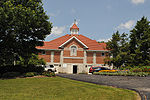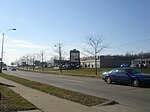Barberton station (Erie Railroad)

Barberton was a train station along the Erie Railroad main line in the city of Barberton, Summit County, Ohio, United States. Located 612.8 miles (986.2 km) from Hoboken Terminal on the Kent Division of the main line, the station first saw service in 1890 while under the ownership of the New York, Pennsylvania and Ohio Railroad, a subsidiary of the Erie Railroad, to help bring people to the new community. Passenger service was terminated on August 1, 1965, with the cancellation of the Atlantic Express (eastbound) Pacific Express (westbound), and multi-day trains from Hoboken to Dearborn Station in Chicago, Illinois. Located at 356 4th Street NW, the city of Barberton was a big part of the large rubber manufacturing area in and around nearby Akron. The depot was constructed by Ohio Columbus Barber, the founder of the community which forked from New Portage Township and was designated a Type IV structure by the Erie Railroad in the Valuation Report to the Interstate Commerce Commission. The depot has also been an important stop for several Presidents of the United States, including two campaign stops for Theodore Roosevelt and William Howard Taft, as well as the funeral train for Warren G. Harding.
Excerpt from the Wikipedia article Barberton station (Erie Railroad) (License: CC BY-SA 3.0, Authors, Images).Barberton station (Erie Railroad)
4th Street Northwest,
Geographical coordinates (GPS) Address Nearby Places Show on map
Geographical coordinates (GPS)
| Latitude | Longitude |
|---|---|
| N 41.02064 ° | E -81.60917 ° |
Address
4th Street Northwest
44203
Ohio, United States
Open on Google Maps










